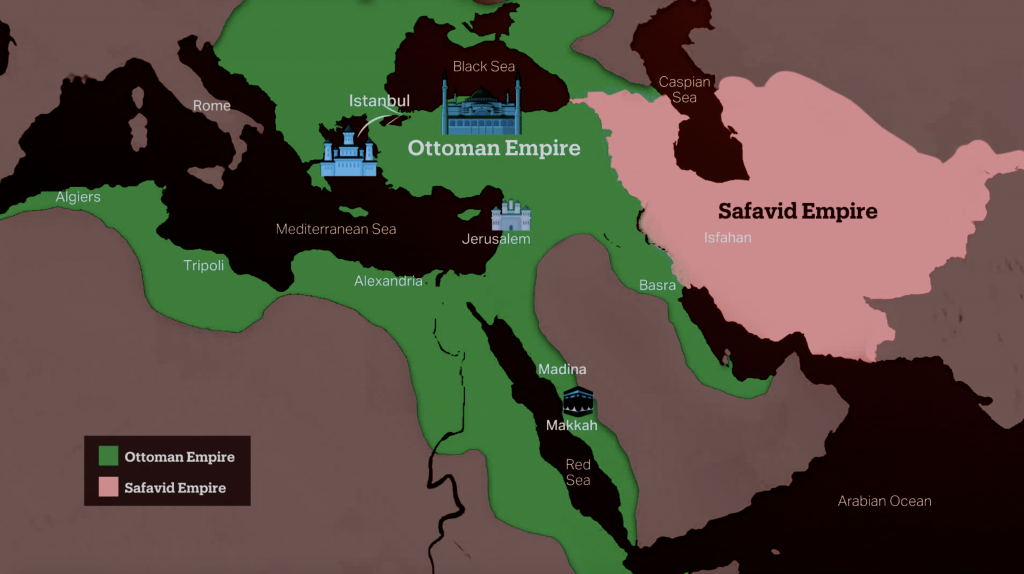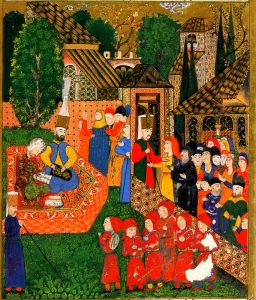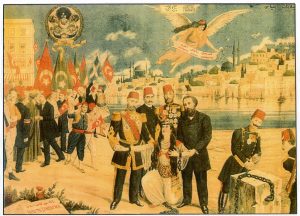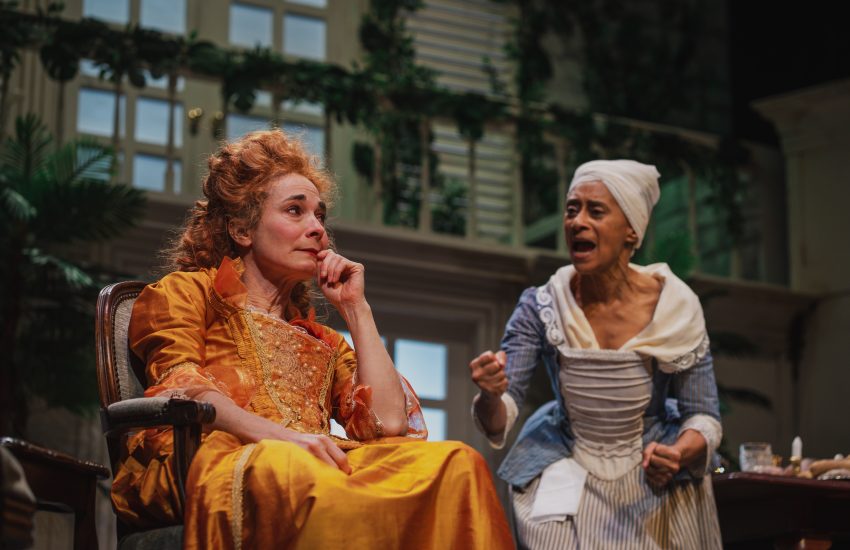Siyah: Deciphering the Ottoman Involvement in the African Slave Trade
This is the second instalment as part of a new series entitled ‘Siyah’ which explores the relationship between the African Diaspora and Turkish social and cultural narratives, with journalist Adama Juldeh Munu. A comparative analysis on both trans-Atlantic slavery and Ottoman slavery regarding Black people. Were Ottoman experiences anomalies or are they simply a reconfiguration of the same system?
‘Slavery’ is a word that is by-and-large misunderstood, for what it was and currently is. Some believe discussing ‘slavery’ in all its guises should be relegated to the annals of time. But if the famous line “Thepast is not dead!” in William Faulkner’s Requiem of a Nun is anything to go by, today slavery powerfully evokes debate, particularly within the African diaspora. It sits at the intersection of conversations focusing on reparations in both Europe and the Americas; the call for the return of stolen African artefacts that lie in some of Europe’s most prestigious cultural institutions; includes the 2017 revelations CNN made on ‘slave auctions’ in Libya amidst the migrant crisis; and countless reports highlighting the mistreatment of domestic workers under the Kafala system in the Middle East. These are not mindless dwellings over past events. They are of the here-and-now.
US chattel slavery largely influences how we conceptualise slavery, which is by no means accidental when one factors how it is represented in classrooms and wider society. Additionally, the search for an all-encompassing definition of ‘slavery’ through a historical lens is tricky because of the distinctive manifestations of slave societies in different times, and the political and economic forces that shaped them. We are forced then to accept that human rights, dignity, freedom, ownership and exploitation are not abstract terms operating in a vacuum, but products of their time.

While contact between Turks and sub-Saharan Africans spans centuries, dating back to the 9th century, a detailed study of that relationship – even pertaining to slavery – is too expansive for this project. I will primarily focus on the late Ottoman period when the enslavement of sub-Saharan Africans was most prominent, and briefly address the reasons cited by historians for which they were brought there, the manifestation of enslavement and abolition, and the ramifications of this history for Afro-Turkish descendants today.
It suffices to say ‘hidden histories’ are either due to wilful design to keep them hidden or the lack of reliable sources that makes proper enquiry possible. Similar to other enquiries into slavery, Ottoman slavery relies heavily on official documents such as court records, Western travellers’ accounts and interpretations of modern historians. Women and slaves, as non-taxpayers, were ‘generally ignored in documents prepared by the Ottoman central government’, and so their voices were largely silenced (Erdem, 1996: 18). What this piece summarises will work within this scope.
Firstly, Ottoman slavery was generally a multi-racial and ethnic system (Kayagil, 2020: 50), not dissimilar to the indentured servitude system preceding race-based slavery in the US. Between the 1300s and 1600s, the devşirme system (a military conscription of young Christian males), prisoners of war and concubinage from Eastern Europe supplied slaves. But at the turn of the 19th century, a more racially classified system emerged with a heavier reliance on sub-Saharan Africans to fill huge labour gaps, brought on by political and economic shifts: inter-state warfare between Muslim and non-Muslim polities, unstable economic conditions, debt, brigandage and scarcity caused by environmental factors. One exception perhaps was in Ottoman Cyprus where enslaved sub-Saharan Africans were common between 1590 and 1640. The courts of Nicosia stipulated that the market value of Black and white slaves was not disparate, contrary to other slave markets (Jennings, 1987: 294-296). Of the 44 in this period whose origins are explicitly stated at least half were of Black origin.

The study of sub-Saharan African slaves in the Ottoman Empire poses a number of challenges. Firstly, Ottoman state sources did not always categorise people by ethnicity, but by religion, and because Saharan Africans were mostly owned by Muslims, they were also in turn considered Muslim. Secondly, the terms used to describe them pose more issues. The word Arap (turkish for Arabs) also applied to trans-Saharan Africans. British and French documentation is helpful because their more distinct notions of race meant they were keen to record the presence of sub-Saharan Africans wherever they went (Ferguson 2010: 171-2). In some parts of the Ottoman Empire, notions of race and identity were fluid. Court documents from Cyprus used interchangeable words for Black people including zenci, siyah and mamluk, the latter also used to describe North Africans. In these cases, we know the enslaved kept their names and identities.
At the height of the slave trade during the mid-19th century, around 1.3 million Central and East Africans were primarily intercepted via the trans-Saharan slave trade through ports in the Nile Valley, the Red Sea, Benghazi, Tripoli, Izmir, Bursa and Beirut. Istanbul and the Hijaz comprising Makkah and Madina were the empire’s two largest slave ports. Trade routes also connected West African cities Bornu, Kano and Tripoli to Mediterranean outposts such as Cyprus. The journey was mostly treacherous for a number of reasons: distance and climatic conditions, and the slaves were required to carry cargoes of animal skins and carnauba wax. They were sold when opportunities arose at other mid-points, be it within Africa or onboard ships bound for the Ottoman Empire (Ferguson, 2019).

The second quality concerns the organisation of slaves among elite and non-elite lines, underpinned by two parallel bases, Islamic law and the Imperial Court. Islamic law permitted the use of this kind of labour, but with certain conditions. Islamic scholars often point to guidelines which promote the kind treatment and manumission of enslaved people. However scriptural guidance did not always underpin social practice (Ferguson, 2019) and where it mattered, imperial administration underpinned a variety of roles that slaves would take up. Elitist roles included kul or military-administration in which male slaves were trained and could ascend to higher positions as viziers to the sultan, and could include eunuchs and conscripted Balkan boys and men. However, it became a less prominent feature of the institution by the late Ottoman period as the number of military expeditions which aided Ottoman territorial expansion receded. The second was harem slavery whereby women would either serve as concubines or wives. Both slave types in urban households had better living standards and room for upward mobility than the following group that often resided in rural areas and were owned by non-elite people: domestic slaves. Both men and women could be domestic slaves, and their function was subject to Islamic law (Toledano, 2011:28-29). The last was large scale institutional enslavement that involved both agricultural slavery and galley slavery (Wilkins, 2013: 347).
The third quality relates to what Madeline Zilfi describes as ‘regionalisms’; forms of ethno-demographics and other social patterns which resembled similar dynamics in Caribbean slave societies (Wilkins, 2013: 346). Michael Ferguson’s work primarily focuses on African slavery outside of Istanbul where roughly two thirds of enslaved people were women. African women were often domestic slaves, while Circassians were mostly concubines. He explains Izmir probably had the largest proportion of sub-Saharan Africans in the late Ottoman empire outside of Egypt and Istanbul, due to a high demand for labour. He has also produced essays looking into the lesser known slave histories of Africans on the Greek island of Crete, relationships with diaspora cultures and religions, as well as their slow ‘disappearance’. Esma Durugönül is currently working on a survey to collect information focusing on stories of Afro-Turk descendants in Antalya, for which there are little to no surveys (Durugönül, 2013).

The fourth quality concerns the low-ranking status and exploitation Saharan Africans subsequently experienced. Under Islamic law, any person of any race could be in bondage and manumitted, and mixing was common. However by the 19th century, racial attitudes hardened such that an emancipated Black woman would be expected to marry an emancipated Black man (1994:71). And so, while the variety of slave experiences and roles has convinced some historians that Ottoman slavery was an ‘open system’ (Zilfi 2010), there are cases which echo the harsher realities of Atlantic chattel slavery. While Suraiya Faroqhi’s Stories of Ottoman Men and Women (2002) demonstrates that both Black and white slaves were considered property, sometimes shared among spouses, slaves were bought and sold and generally had no control over their lives, or their children’s lives. In her book, Eve Troutt Powell reports cases where enslaved women were raped, forced to abort their babies, or in cases where they did give birth, new-borns would be taken away from the enslaved mothers in Egypt and Sudan. Jane Hathaway’s work looks at the roles of Black eunuchs that were considered valuable property and would have undergone extremely violent castration.
Ferguson highlights negative attitudes by Turks in Izmir towards Afro-Turks in their attempt to practice and celebrate African traditions such as the now annual Calf festival: “The newspapers Hizmet and Ahenk are examined together here, as the editor for both was Tevfik Nevzat (1865–1905), a former lawyer and school teacher who was deeply influenced by both Western philosophies and the writings of Namık Kemal, one of the founders of the highly influential Young Ottoman political movement.
Nevzat’s influential newspaper articles criticizing African practices at their annual festival demonstrate the tension between emerging Ottoman concepts of belonging, identity, and citizenship, and the integration of emancipated Africans into Ottoman society. The impressions of African residents of Izmir, revealed in the pages of both newspapers, were focused on their ‘wild’ and ‘savage’ behaviour, stemming from a perceived lack of culture and civility” (Ferguson: 2019:).
Lastly, Ottoman slavery lacked the kind of firebrand abolition movement among the enslaved and their supporters. On the one hand, the legal permissibility of slavery against the interference of foreign governments like the British and the spectrum of responses from Ottoman officials did not create the kind of firebrand halt to slavery that existed elsewhere. That interference took place following Britain’s ‘role’ in stamping out the trans-Atlantic slave trade in the early 1800s. Hakan Erdem argues there are no specific abolition juncture points where slavery impacted people of African descent within Ottoman slavery and “no abolitionist tracts popularising the subject and bringing home the sufferings of slaves – real or imagined. Today, the abolition of slavery, as one of the past human achievements, is not part of the curriculum in schools in modern Turkey. Nor is there a specific date of abolition (as in the West Indies or the USA) which could be used as a dramatic starting-point for such a study” (Erdem, 1996).
But that’s also true for how abolition worked in other parts of the African diaspora. For instance, different emancipation days took place across the South following the US civil war, the last of which took place in Texas on June 19th 1865.
The long-drawn-out independence war between Haiti and France between 1791 and 1804 also speaks to the longitudinal nature of abolition and the role enslaved Africans played in their own liberation. Likewise, Ottoman Tunisia was the first to abolish slavery in the Muslim world by 1846 to curtail European intervention and to protect against enslaving Christians for ransom, after the French occupation of Algeria in the 1830s.
While the importation of slaves was abolished in 1857, as an institution it remained legal until the fall of the empire in 1922. The call for abolition was both “culturally loaded and sensitive interference” during the Tanzimat – a period of reform (1839-1876) which included moves to abolish slavery. In the introduction to his essay Late Ottoman concepts of slavery (1830s-1880s), Toledano says:
“Ottoman statesmen (from 1840), Young Ottoman activists (in the 1860s), and the Tanzimat writers (during the mid-1870s) were faced with the need to respond to Western abolitionism. In spite of their different reactions, all three groups rejected the Western image of Ottoman slavery by adopting a bifurcated strategy: to the outside world, they projected the image of kul/harem slavery as the only type of Ottoman slavery, while simultaneously, at home, they treated domestic and agricultural slavery as the only types of Ottoman slavery. This is a case of amplification and deletion as a measure of resistance to extra-cultural interference. The unpleasant, negative, disturbing manifestations of slavery – the traffic in and the lot of African menial slaves – were deleted from the representation of Ottoman slavery. At the same time, the realities of kul/harem slavery were amplified to serve in the intercultural exchange. Because of the rigidity of Western abolitionism, no alternative Ottoman counter strategies were developed. In the West, a campaign to abolish only domestic and agricultural slavery – indeed, the predominant and most painful types – was never contemplated” (Toledano).

Recent slavery institutions, both Atlantic and trans-Saharan, have huge implications on how race-based theories and practices have not outlived their purpose in today’s world, but are sustained by it. Police brutality, the criminal justice system, forced ghetto-isation of Black communities, and racial wealth gaps in Western industrialised nations can be linked back to white supremacist ideals which arose during the height of these slave trades.
Pulitzer Prize winner and New York Times journalist Nikole Hannah Jones’ The 1619 Project looks into how American slavery speaks to the nation’s struggle to reconcile with its historical, social and political paradoxes, as both a self-proclaimed bastion of freedom and liberation and instigator of the denigration of Black people. It also argues that while Black Americans have been historically denied the fruits of American democracy, they have been its greatest proponents. This was met with opposition by the now lame-duck president Trump, who launched the 1776 commission to police initiatives that critique any conversation that challenges the notion of systemic racism. Even narratives on Europe’s connection with chattel slavery is awash with dismissals and the downplay of the brutal realities of plantation life in former Caribbean colonies. A great introductory article on this is written by my former colleague, Amandla Thomas-Johnson on this subject. However, the amnesia over this part of the empire’s history, as Ehud Toledona puts it, is attributed to contradictions in seeking a progressive future, while being weighed down by a less savoury past on the issue of race. This is particularly true for most European nations today, but it’s reverberated in the decades of erasure and marginalisation of Afro-Turks, most likely brought about by the new Turkish Republic and Turkish nationalism since 1923.
Sadly, problematic prejudicial attitudes have in some instances continued to shape the image of the “Black experience in Turkey’s subconscious”, which can be traced back to slavery. In his piece ‘ Is there really no anti-Black racism in Turkey?’, journalist Tunay Altay recounts a recent interview with Yalçın Yanık, the first Black candidate to run for parliamentary elections in 2018, who said, “Even the ones who call themselves democrats in Turkey sometimes act racist and make discriminatory comments about my Blackness”. Altay goes on to vigorously survey the various ways in which the ‘Arab Mammy’, the ‘Yam Yam’, ‘Savage’ and ‘Sexualised Black body’ are represented in Turkish television and film. “Connected to this history of slavery in Ottoman Turkey, the Arab mammy (Arap Bacı or Bacı Kalfa in Turkish) stereotype was one of the early representations of Black women during the Yeşilçam era (Turkey’s old cinematic era between the 1950s and 1970s).” This of course mirrors both American minstrelsy and caricatures depicting Black people in inferior positions such as the African-American actress’ role as ‘Mammy’ in Gone with the Wind.
But in recent years, Afro-Turks have been taking matters into their own hands by setting up initiatives that both enlighten their histories and dispel myths around their Blackness and heritage. In 2006, the Afro-Turk Solidarity Association was set up by historian Mustafa Olpak to bring to light the forgotten histories and presence of Afro-Turks and recently arrived African immigrants. This has included oral history projects of Afro-Turkish descendants and projects showcasing the experiences of recently arrived African migrants, whose lives in Turkey add to the conversation around Blackness in the country, which has gained both political and media appraisal on a national and international level. Olpak’s autobiographical work was the basis for Gül Büyükbeşe’s first documentary ‘Baa Baa Black Girl’ or Arap kızı camdan bakıyor (2006), and a Turkish Radio Television documentary looked at their class positions in “Black, African and Turk – Siyahım, Afrikalıyım, Türküm” (2010). Both remain an important resource for anyone interested in finding out about the longstanding presence of Turks of African origin and their lives in the villages in Izmir. In 2008, Tarih Vakfı or the History Foundation compiled an oral history project turned book to open up public discussions on the history of slavery and its repercussions on Afro-Turks and how they perceive their identity as an ethnic group.



Incredibly interesting stuff, thanks for posting!
My fathers family in Northern Cyprus has always been mixed race so, myself and my brother are dark skinned my two sisters pale skinned but all have afro hair.
My father talked a lot about our great great grandfather being runaway slaves from Eygypt under Ottoman rule . He was called Black [ Siyah ] Mustafa and had a brother Black Mohamed.
As to their being slaves i im not sure as they accumulated massive acres of agricultural land in the part known now as Mehmetcik Koy then known as Galatya.
We are still mixed race in looks and i for one have two mixed race Caribbean sons who look just like my uncle.
Its good to be able to trace back our origins so thank you for your article.
That is so interesting, thanks so much for sharing that and for reading the article too!
Mashallah, Afro-Turks have contributed a lot to the Ottoman Empire. Millions of African women were brought from Sudan and Egypt and contributed to a large majority of the population in southern Turkey. They used to call Sudan/Egypt the mother of southern Turkey. I think the most hurtful part, is that we were wiped out of most or all the history in their schools and many people who are of African descent are oblivious to the fact. Inshallah, I hope that we can be recognised for our contributions.
Thanks for reading!